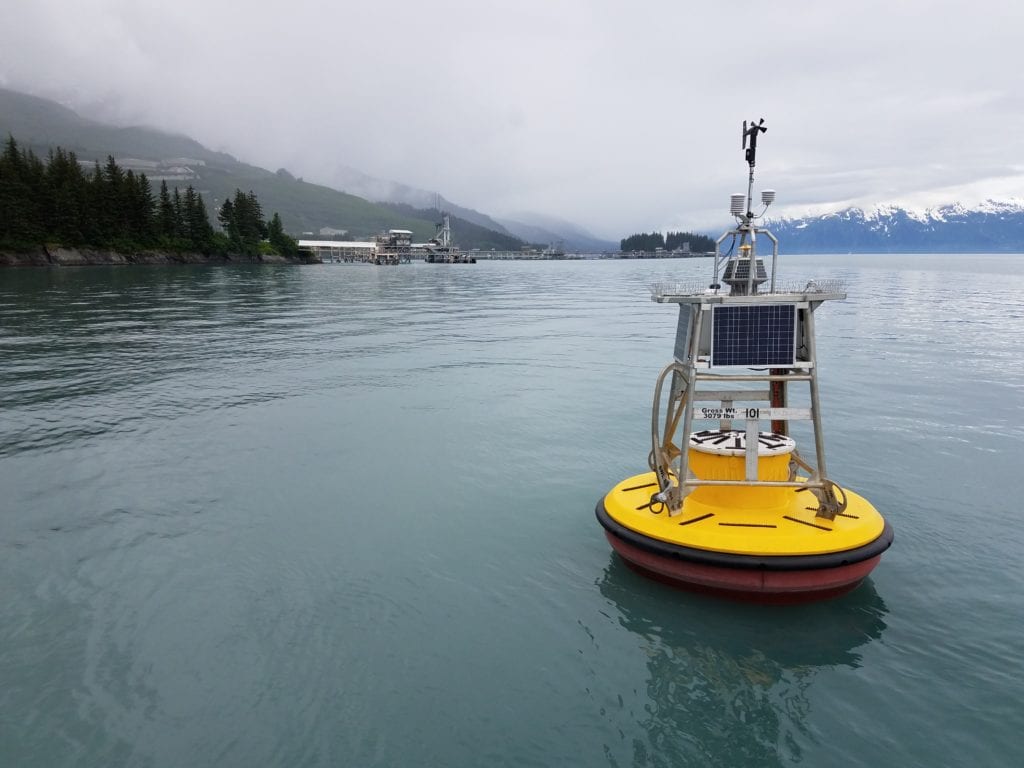
New weather buoys deployed at the Port of Valdez to promote environmentally safe operation of the busy Valdez Marine Terminal and associated tankers are also being hailed as a safety asset for a variety of other maritime users in Prince William Sound.
“This is another excellent example of how collaborative science can have wide-ranging impacts for the betterment of all,” said Donna Schantz, executive director of the Prince William Sound Regional Citizens’ Advisory Council. PWSRCAC partnered with the National Oceanic and Atmospheric Administration to establish the 36th PORTS (Physical Oceanographic Real-Time System) in a nationwide network.
“This new system and others like them around the country reduce ship accidents by more than 50 percent, increase the size of ships that can get in and out of seaports, and reduce traffic delays,” said Steven Thur, acting deputy director of NOAA’s National Ocean Service. “They also provide real-time, resilience-ready data as coastal conditions rapidly change, potentially threatening our coastal communities.”
These systems also improve hazardous spill response and enhance recreational activities, NOAA officials said.
The Valdez PORTS consists of an existing NOAA National Water Level Observation Network station at Valdez and two new meteorological-ocean buoys, operated and maintained by the citizens’ advisory council that measures tidal currents, wind, air temperature, water temperature and barometric pressure.
One of the buoys lies off Jackson Point, at the Alyeska Pipeline Service Company’s Valdez Marine Terminal; the other near the Valdez Duck Flats. The buoys collect data that helps to improve understanding of the meteorological and physical oceanographic environment at the terminal and Duck Flats, PWSRCAC officials said.
The advisory council’s mandate from Congress includes studying wind and water currents and other environmental factors in the area of the Alyeska terminal that may affect prevention response to, containment of and cleanup of an oil spill. The port lies in the upper end of Prince William Sound, site of the Exxon Valdez oil spill disaster of 1989 during which the Exxon Valdez oil tanker hit Bligh Reef and spilled nearly 11 million gallons of crude oil into the Sound.
Council staff work with the oil industry and regulators to ensure response readiness, evaluate risks and come up with solutions.
Data gathered by the buoys is already being provided to the Alaska Oceans Observing System, a regional association of the NOAA-led U.S. Integrated Ocean Observing System. PORTS helps bring in the buoy data and merge it with the data from the National Water Level Observation Network, enabling users to get all that data through one website.
By monitoring the state’s coastlines and ocean waters, AOOS helps provide information needed by coastal residents to make better decisions on their use of the marine environment.
The purchase of the two buoys was made possible through donations from Fairweather Science and partnerships with the Prince William Sound Science Center Alyeska Pipeline Service Company, the city of Valdez and Valdez Fisheries Development Association. A cooperative effort between the U.S. Coast Guard and Alyeska Pipeline has allowed the council access into the marine security zone that borders the terminal.
PORTS itself is a cost-shared partnership with local port authorities, pilot associations, the Coast Guard, U.S. Army Corps of Engineers the U.S. Navy, academia and other stakeholders nationwide.
The PORTS program dates back to 1991, when it was established in Tampa Bay, Florida, in the wake of a deadly 1981 collision. The incident involved an inbound freighter that collided with the Sunshine Skyway Bridge, causing the bridge to collapse and kill 35 people. NOAA officials said that accident underscored the need for integrated real-time information to provide comprehensive situational awareness to mariners charged with operational decisions.





